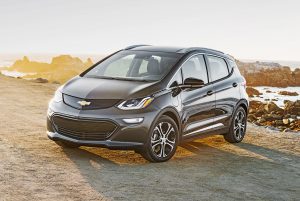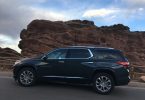 Okay so here’s the deal. Last month, I learned how to drive the 2017 Chevrolet Bolt EV while coasting Colorado’s Peak to Peak Highway — a scenic mountain route with breathtaking descents, winding roads and sharp turns — without putting my foot on the brake. No lie. My assignment for this driving event was to learn more about the EV’s regenerative braking feature, which has the capability to provide one-pedal driving. There were times though when my heart dropped and my foot raced to the traditional brake pedal – and that’s okay. It is there in case of emergency or if that’s more comfortable.
Okay so here’s the deal. Last month, I learned how to drive the 2017 Chevrolet Bolt EV while coasting Colorado’s Peak to Peak Highway — a scenic mountain route with breathtaking descents, winding roads and sharp turns — without putting my foot on the brake. No lie. My assignment for this driving event was to learn more about the EV’s regenerative braking feature, which has the capability to provide one-pedal driving. There were times though when my heart dropped and my foot raced to the traditional brake pedal – and that’s okay. It is there in case of emergency or if that’s more comfortable.
According to press info from Chevrolet, the one-pedal driving combines the highest available level of regenerative braking, which captures otherwise lost energy from deceleration and sends it back to the Bolt EV battery pack for the greatest total vehicle range. One-pedal driving can add up to five percent of range to the Bolt EV.
Along with additional software controls, regen braking allows the driver to stop the vehicle without using the brake pedal in certain driving conditions. The regenerative braking engages automatically when easing off the accelerator. But like in the Chevy Volt, the Bolt EV has a ‘Regen on Demand paddle’ on the steering wheel that significantly increase the capacity of the regen.
Yeah, I’m still coming to terms with how this works. I’ve learned that progressively stronger levels of regen braking are employed in all Bolt EV driving through a series of four driver-selectable modes:
- Operating in Drive and easing off the accelerator.
- Operating in Drive and using the Regen on Demand paddle on the back of the steering wheel.
- Operating in Low and easing off the accelerator.
- Operating in Low and using the Regen on Demand paddle in tandem.
Bolt EV’s drive system uses a single, high-capacity electric motor for propulsion. The motor is capable of producing up to 266 lb.-ft. (360 Nm) of torque and 200 hp (150 kW) of motoring power. The EV can go from 0-60 mph in less than seven seconds.
 Needless to say, I did not try this on winding mountain roads. I’ll take them at their word.
Needless to say, I did not try this on winding mountain roads. I’ll take them at their word.
Chevrolet reports this 2017 EV is the result of interviews with electric vehicle enthusiasts, who wanted EVs to provide a longer range, be fun to drive, be a functional crossover and be affordable. It has an EPA-estimated 238 miles of range. The value of state and federal tax breaks range from state to state, but it is well worth investigating. It’s estimated at $30,000 after full federal tax credit. Drivers in the market for small crossovers have something new to consider when making their next purchase. The Bolt EV is available in Colorado now and will be offered nationwide by August.
Visit Chevrolet.



